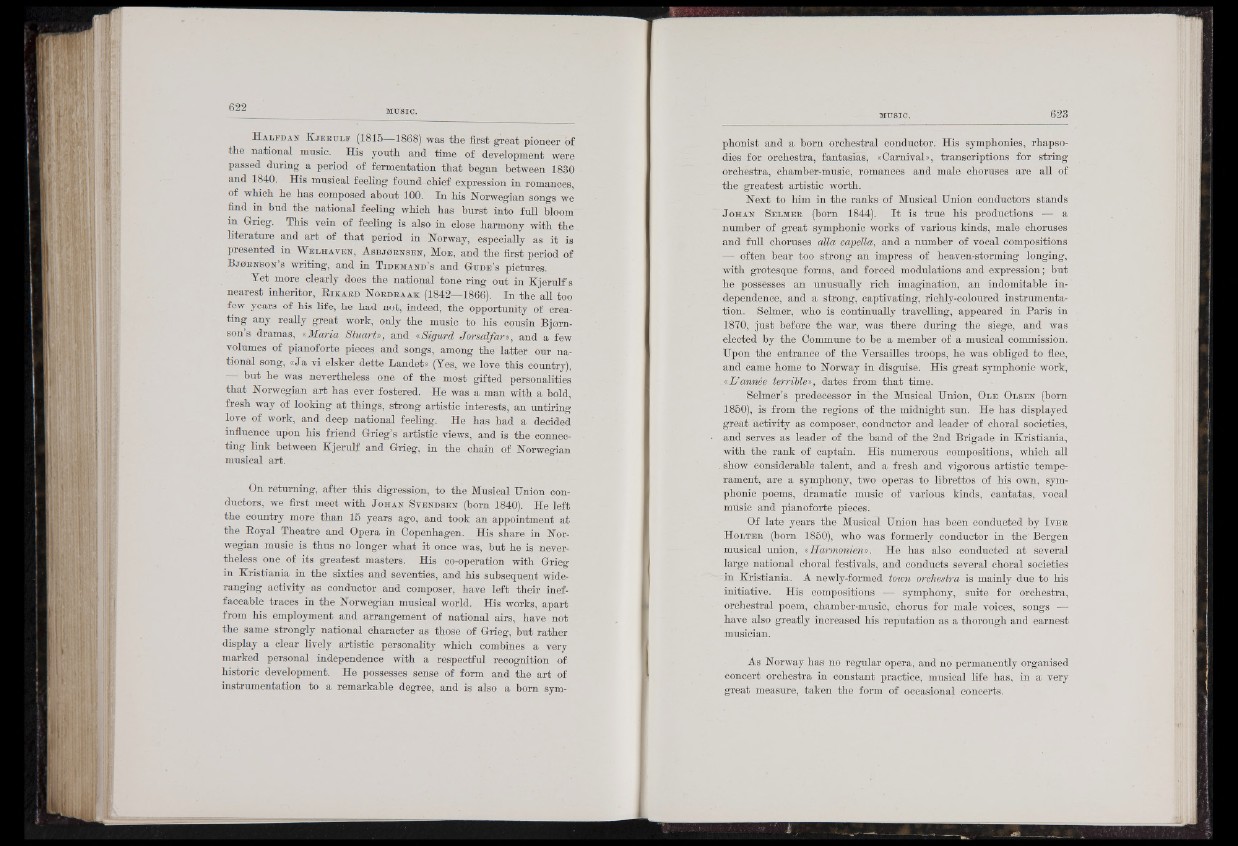
H a l f d a r K j e i u ' l f (1815— 1868) was the first gTeat pioneer of
the national music. His youth and time of development were
passed during a period of fermentation that began between 1830
and 1840. His musical feeling found chief expression in romances,
of which he has composed about 100. In his Norwegian songs we
find in bud the national feeling which has burst into full bloom
in Grieg. This vein of feeling is also in close harmony with the
literature and art of that period in Norway, especially as it is
presented in W e l h a v e n , A s b j o r n s e n , M o b , and the first period of
Bj0it]srsoii’s writing, and in T i d e m a n d ’s and Gunn’s pictures.
Yet more clearly does the national tone ring out in Ejerulf’s
nearest inheritor, R ik a r d N o r d r a a k (1842—1866). In the all too
few years of his life, he had not, indeed, the opportunity of creating
any really great work, only the music to his cousin Bjorn-
son’s dramas, iMaria Stuart», and «Sigurd Jorsalfar», and a few
volumes of pianoforte pieces, and songs, among the latter our national
song, «Ja vi elsker dette Landet» (Yes, we love this country),
- but he was nevertheless one of the most gifted personalities
that Norwegian art has ever fostered. He was a man with a bold,
fresh way of looking at things, strong artistic interests, an untiring
love of work, and deep national feeling. He has had a decided
influence upon his friend Grieg’s artistic views, and is the connecting
link between Ejerulf and Grieg, in the chain of Norwegian
musical art.
On returning, after this digression, to the Musical Union conductors,
we first meet with J o h a n S v e n d s e n (born 1840). He left
the country more than 15 years ago, and took an appointment at
the Royal Theatre and Opera in Copenhagen. His share in Norwegian
music is thus no longer what it once was, but he is nevertheless
one of its greatest masters. His co-operation with Grieg
in Eristiania in the sixties and seventies, and his subsequent wide-
ranging activity as conductor and composer, have left their ineffaceable
traces in the Norwegian musical world. His works, apart
from his employment and arrangement of national airs, have not
the same strongly national character as those of Grieg, but rather
display a clear lively artistic personality which combines a very
marked personal independence with a respectful recognition of
historic development. He possesses sense of form and the art of
instrumentation to a remarkable degree, and is also a born symphonist
and a born orchestral conductor. His symphonies, rhapsodies
for orchestra, fantasias,SïCarnival», transcriptions for string
orchestra, chamber-music, romances and male choruses are all of
the greatest artistic worth.
Next to him in the ranks of Musical Union conductors stands
J ohan S e l h e r (bom 1844). I t is true his productions — a
number of great symphonic works of various kinds, male choruses
and full choruses alia eapella, and a number of vocal compositions
^S o ften bear too strong an impress of heaven-storming longing,
with grotesque forms, and forced modulations and expression; but
he possesses an unusually rich imagination, an indomitable independence,
and a strong, captivating, richly-coloured instrumentation.
Selmer, who is continually travelling, appeared in Paris in
1870, just before the war, was there during the siege, and was
elected by the Commune to be a member of a musical commission.
Upon the entrance of the Versailles troops, he was obliged to flee,
and came home to Norway in disguise. His great symphonic work,
«L ’armée terrible», dates from that time.
Selmer’s predecessor in' the Musical Union, O l e O l s en (born
1850), is from the regions of the midnight sun. He has displayed
great activity as composer, conductor and leader of choral societies,
and serves as leader of the band of the 2nd Brigade in Eristiania,
with the rank of captain. His numerous compositions, which all
show considerable talent, and a fresh and vigorous artistic temperament,
are a symphony, two operas to librettos of his own, symphonic
poems, dramatic music of various kinds, cantatas, vocal
music and pianoforte pieces.
Of late years the Musical Union has been conducted by I ver
H o l t er (born 1850), who was formerly conductor in the Bergen
musical union, «Harmonien». He has also conducted at several
large national choral festivals, and conducts several choral societies
in Eristiania. A newly-formed town orchestra is mainly due to his
initiative. His compositions - symphony,, suite for orchestra,
orchestral poem, chamber-music, chorus for male voices, songs H
have also greatly increased his reputation as a thorough and earnest
musician.
As Norway has no regular opera, and no permanently organised
concert orchestra in constant practice, musical life has, in a very
great measure, taken the form of occasional concerts.